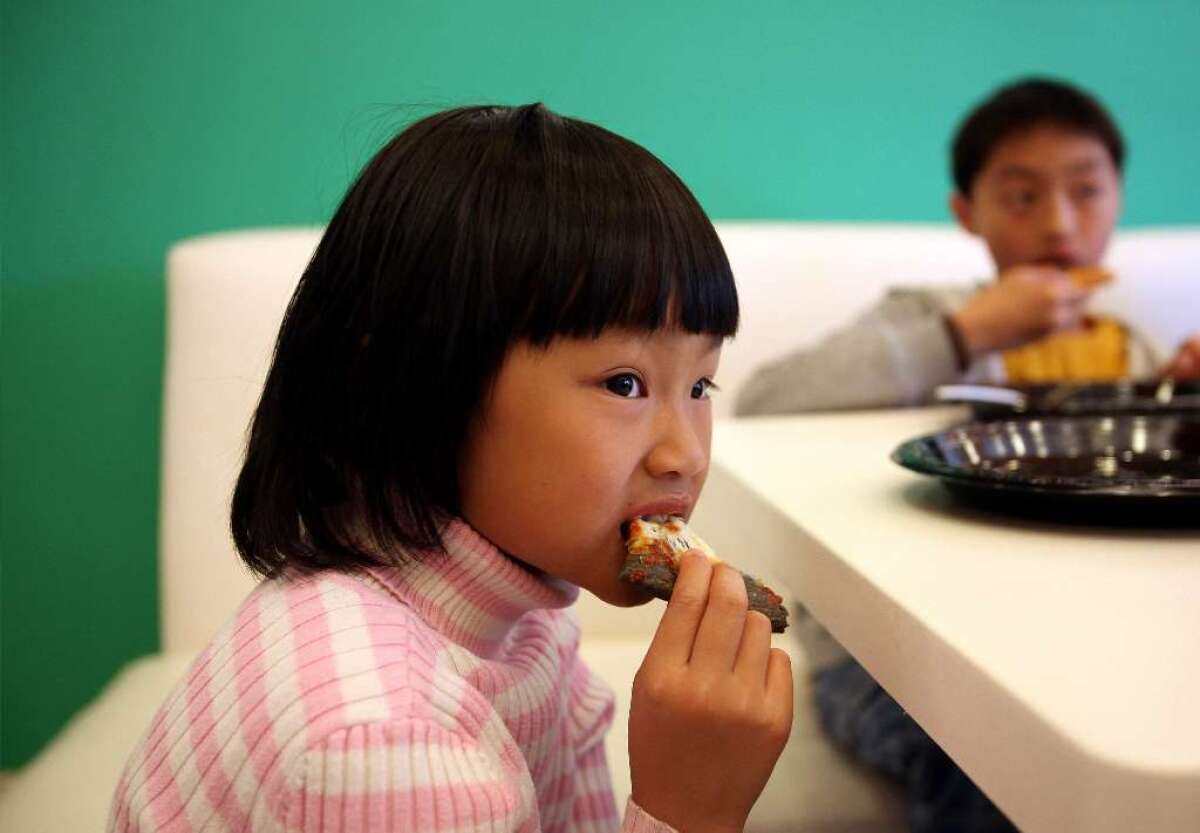Experts zero in on pizza as prime target in war on childhood obesity

- Share via
Kids love pizza, but a new study shows that it doesn’t love them back.
On days when children eat pizza, they consume an average of 408 additional calories, three additional grams of fat and 134 additional milligrams of salt compared with their regular diet. For teens, putting pizza on the day’s menu adds 624 calories, five grams of fat and 484 milligrams of salt.
The analysis, published online Monday by the journal Pediatrics, examines pizza’s contribution to the childhood obesity crisis because it is so widely consumed. On any given day, 22% of kids between the ages of 6 and 19 eat pizza. (That compares to 14% of toddlers and 13% of Americans overall.) The only foods more popular with kids are “grain desserts,” a category that includes cakes, cookies and doughnuts.
Health policy researcher Lisa M. Powell of the University of Illinois at Chicago and her colleagues used data from the National Health and Nutrition Examination Survey to assess pizza’s impact on children’s diets. Participants in NHANES, a project of the Centers for Disease Control and Prevention, complete dietary recalls that list all the foods and drinks they consumed in the previous 24 hours. Responses from 7,443 children between the ages of 2 and 11 and 6,447 adolescents between the ages of 12 and 19 were involved in the new study.
The results revealed that younger kids eat 83 calories’ worth of pizza a day and teens eat 143 calories of the dish each day, on average. Those amounts were high enough to account for 5% and 7% of total daily calories, respectively.
On days when pizza is eaten, it composes 22% of children’s calories and 26% of teens’ calories, the researchers found.
Those figures reflect pizza consumption in 2009 and 2010. Though high, they were were even worse in 2003 and 2004. Compared with the earlier period, the more recent figures were 25% lower for younger children and 16% lower for teens, according to the study.
The decline in pizza consumption was seen mainly in younger children who are white or African American, bringing them closer to the consumption levels of Latino children. Children from middle-income and high-income families – but not low-income families – ate a little less pizza at the end of the study compared with the beginning, though the change wasn’t big enough to be statistically significant.
The amount of pizza eaten by teens remained basically the same throughout the study.
To the extent that kids cut back on pizza, they did so at dinnertime. Calories consumed in the form of pizza dinners fell by 40% for younger children and 33% for teens. By the end of the study period, the amount of pizza eaten for dinner was comparable to the amount eaten for lunch.
Kids also ate a small amount of pizza for breakfast or as snacks. The snack pizza was particularly troubling to the researchers. On days when children had this indulgence, they ate 202 more calories over the course of the day compared with days when they didn’t. For teens, pizza snacks added 365 calories to the daily total.
Powell and her colleagues stopped short of declaring a war on pizza, but they said its effect on kids’ diet was similar to that of sugary drinks. Pizza “should become a target for counseling for the prevention and treatment of obesity in pediatric practice,” they wrote.
For a healthy serving of medical news, follow me on Twitter @LATkarenkaplan and “like” Los Angeles Times Science & Health on Facebook.





